- Application Rate
- Effective Swath Width
- Uniformity
- Recommended Calibration Method
- Spread Patterns
- Average Application Rate
- Summary
- Resources
Calibrating a manure spreader is a simple, easy management tool that can help producers use nutrients from animal manure efficiently and safely. Over-application or uneven application of manure wastes nutrients and increases the chance of ground or surface water contamination. By knowing the application rate of the manure spreader, correct amounts of manure can be applied to meet crop needs. The procedure takes less than an hour but can save hundreds of dollars through more efficient use of manure nutrient resources. Calibration, along with timely application to provide nutrients when crops can use them, helps ensure efficient and safe use of animal manures.
This publication primarily focuses on rear discharge, twin spinner spreaders common for poultry litter application in the southeast (Figure 1). The concepts discussed, however, do apply to other types of spreaders. Slight changes in the described procedures may be required to calibrate other types of spreaders.
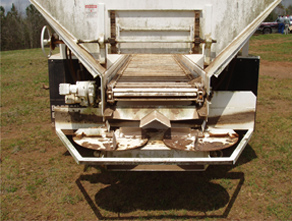
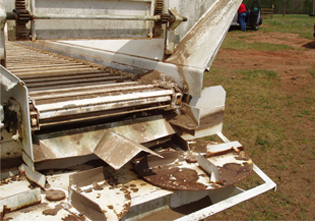
Manure spreader calibration has three main goals:
- Determine application rate (tons per acre applied at a given setup and speed).
- Determine the effective swath width (how far apart each pass should be).
- Optimize the uniformity of distribution of manure.
Application Rate
The application rate can be determined by mass balance. (Weigh the spreader before and after spreading and determine the area covered.) This procedure tells us how much was applied over a given area, but it tells us nothing about how evenly the manure was applied. A much better method is to catch samples at locations across the path of the spreader and use them to determine the spreader application pattern. The application rate at a given point can be determined using the amount (lbs) of manure captured on a tarp at that point and the following simple formula:
Application Rate (tons/acre) = Sample weight (lbs) x 21.8/tarp area (ft2).
To make the math even simpler, if you use tarps that are 4' 8" x 4' 8", the area of those tarps is 21.8 ft2 and the application rate in tons/acre is equal to the pounds of manure on the tarp.
Effective Swath Width
 Figure 2. Normal distribution pattern from most manure spreaders.
Figure 2. Normal distribution pattern from most manure spreaders.To determine effective swath width, understand that the distribution from a spreader typically resembles a triangle with the maximum application rate near the spreader path and decreasing rates farther from the spreader path (Figure 2). When the spreader pattern looks like this, the edge of the effective swath width occurs at the point where the application rate is one-half the maximum rate. If the rate is 4 tons/acre in the middle, and decreases to 2 tons per acre 20 feet to the side of the spreader, then 20 feet is the edge of the effective swath. Since this occurs on both sides of the spreader, the effective swath width is 40 feet. The overlap is necessary to even out the distribution of the litter. If the spreader paths are 40 feet apart, the overlapping patterns will produce a uniform application rate of 4 tons/acre.
Uniformity
Uniformity can be achieved only with an acceptable distribution pattern (see Spread Patterns section) and spacing the paths based on the effective swath widths.
Recommended Calibration Method
The following procedure works for solid or semi-solid animal waste including broiler litter, horse and cow manure.
Materials Needed
- Large plastic bucket (5-gallon bucket) or cat litter box
- Seven identical plastic tarps (4'8" x 4'8" or similar size)
- Tent stakes or large nails (4 per tarp)
- Scale (measure to nearest 1/10 lb)
- 100' tape measure
- Broom
- Small flags or colored rag
- Calculator
Procedure
- Weigh individual tarps and bucket and note the dimensions of the tarps.
- Lay tarps out equally spaced in a line perpendicular to the travel of the spreader (Figure 3). Eight-foot (on-center) spacing is typical, but spacing may be more or less depending on how far the spreader throws manure. Fasten tarp at each corner with a tent stake or long nail through eyelets.
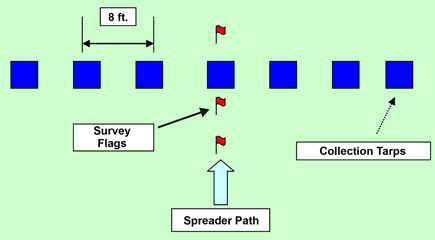 Figure 3. Tarp layout for calibrating manure spreader.
Figure 3. Tarp layout for calibrating manure spreader.- Push a flag into the ground at the center of the desired spreader path. (Center of the middle tarp for most spreaders — edge of first tarp for side-discharge spreaders.) This helps the driver center the spreader as he drives over the tarps.
- Drive the spreader over the tarps at the speed normally driven when applying manure on the field. Make sure speed and application rate are under steady state conditions. Record the speed and spreader settings.
- Depending on how sticky the manure is, there are two options: (a) If the manure is dry, carefully pull up the tarps and pour the manure into the bucket; (b) if manure is sticky, carefully pull up the tarps. Fold the tarps and stuff them into the plastic bucket.
- (a) If the manure is dry, weigh the bucket and waste. Subtract the weight of the empty bucket. This will give the pounds of manure applied to the sheet or (b) if the manure is sticky; weigh each tarp in the bucket. Subtract the weight of the tarp and the bucket to get the pounds of manure applied to each sheet.
- Convert pounds/tarp to tons/acre by multiplying by 21.8 and dividing by the area of the tarp.
- Plot the spreader distribution on a graph with the vertical (“y”) axis equal to the application rate for each tarp and the horizontal (“x”) axis as the distance from the center of the spreader path to the center of each tarp (Figure 4). An Excel spreadsheet is available that will do the plotting automatically. (See Resources section.)
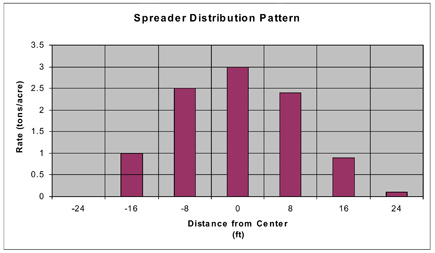 |
|||||||
| Tarp area: 21.8 ft2 | Tarp spacing: 8 ft | ||||||
| Tarp # | 1 | 2 | 3 | 4 | 5 | 6 | 7 |
| 0.0 | 1.0 | 2.5 | 3.0 | 2.4 | 0.9 | 0.1 | |
| Figure 4. A sample data sheet and graph of distribution pattern. | |||||||
- The points on both sides of the center that are approximately one-half the maximum value represent the edge of the effective swath width. By identifying the effective swath width and overlapping swaths each trip up or down the field, even distribution of the manure can be achieved.
- Sweep the tarps (and wash if necessary) to remove any manure before folding.
Spread Patterns
Acceptable spread patterns are shown in Figure 5. The area between the dashed lines represents the approximate effective swath width. If spreader paths are spaced at this interval, a uniform distribution should be achieved.
Unacceptable patterns are shown in Figure 6. A uniform distribution pattern is almost impossible to achieve without an acceptable spread pattern. If your spreader does not spread any of the acceptable patterns or something very close, make adjustments to the spreader using the operators manual until an acceptable pattern is realized.
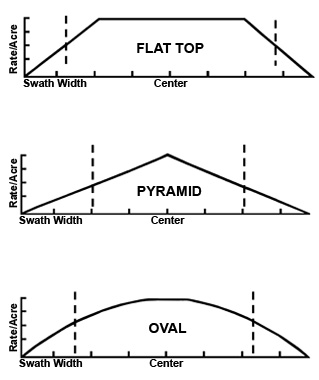 Figure 5. Acceptable spread patterns.
Figure 5. Acceptable spread patterns.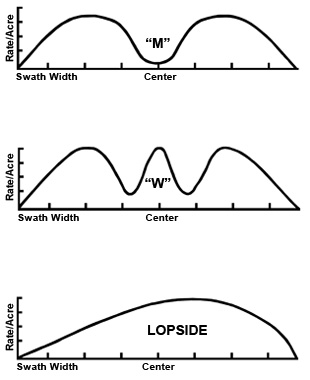 Figure 6. Unacceptable spread patterns.
Figure 6. Unacceptable spread patterns.
A common problem seen with twin disk spreader trucks is that the door over the spinner disks is opened so wide that much of the litter bypasses the disks and is deposited directly on the ground behind the spreader. This causes a high peak in the center of the distribution pattern with much lower rates on either side of the truck. This pattern is seen in Figure 7 as the “single pass” distribution (solid line). Figure 7 further illustrates that, while increasing lane spacing from 16 to 40 feet lowers the average application rate (from 3.3 to 1.3 tons/acre), application rate remains uneven for all lane spacings shown.
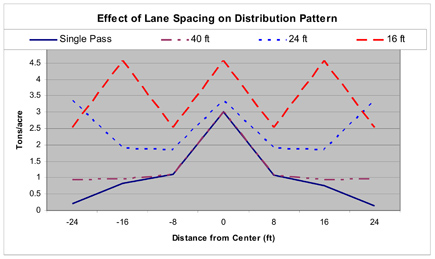 Figure 7. Lane spacing effects on uniformity and application rate.
Figure 7. Lane spacing effects on uniformity and application rate.Operators commonly try to compensate for this problem by speeding up the spinners, but this only causes the manure that hits the disks to be thrown farther. Much of the manure still bypasses the spinners, causing a high peak at the center and a wider distribution on either side. Disk speed for most trucks should not be more than approximately 600 rpm for spreading litter or manure. The uniformity can be improved by narrowing the swath width, but the real remedy for this problem is to partially close down the gate so all of the manure is spread by the spinners.
Average Application Rate
If the spread pattern is acceptable and a proper swath width is used, then the average application rate is the amount at the center of the pattern. If the lane spacing is other than the effective swath width, or if the pattern is not one of the acceptable ones, the average application rate can be estimated by averaging the amount of litter recovered on the seven sample tarps and adjusting this number to account for lane spacing.
Average Application Rate = (Average Rate for 7 tarps) x 56/Lane Spacing
For instance, if we use the data from Figure 4, the average amount on the seven tarps is 1.4 tons/acre, and the tarps were sampling an area 56 ft. wide. (7 tarps x 8-ft spacing = 56 ft.) If no overlapping of patterns takes place, the manure would be applied at 1.4 tons/acre. If the spreader lanes are 40 feet apart, then the average application rate would be 56/40 x 1.4 = 2.0 tons/acre. If the lanes were 25 feet apart, the average rate would be 56/25 x 1.4 = 3.2 tons/ acre. Note that by looking at Figure 4, we can see that the effective swath width is approximately 25 feet, and the 3.2 calculated above is approximately equal to the maximum rate of 3 tons/acre.
Summary
Manure spreader calibration enables the operator to know how much manure is being applied and that the application is uniform across the field. Once the spreader pattern is determined and adjusted if needed to obtain an acceptable pattern, the lane spacing that will yield an even distribution of manure nutrients can be determined.
These nutrients, when applied during the growing season, can then be safely used by the crop, adding to the producer’s bottom line and lowering the risk of surface or ground water contamination.
Resources
A computer spreadsheet is available for use in plotting spreader patterns and calculating application rates based on calibration data. It can be found on the AWARE home page. Look under Nutrient Management Planning in the menu bar, then click on NMP Tools to find the dry manure spreader calibration spreadsheet. For further assistance, contact your local county extension agent (1-800-ASK-UGA1).
Status and Revision History
Published on Oct 01, 1994
Published with Major Revisions on Jan 18, 2008
Published on Oct 05, 2010
Published with Full Review on Nov 26, 2013
Published with Full Review on Jul 28, 2022


























































